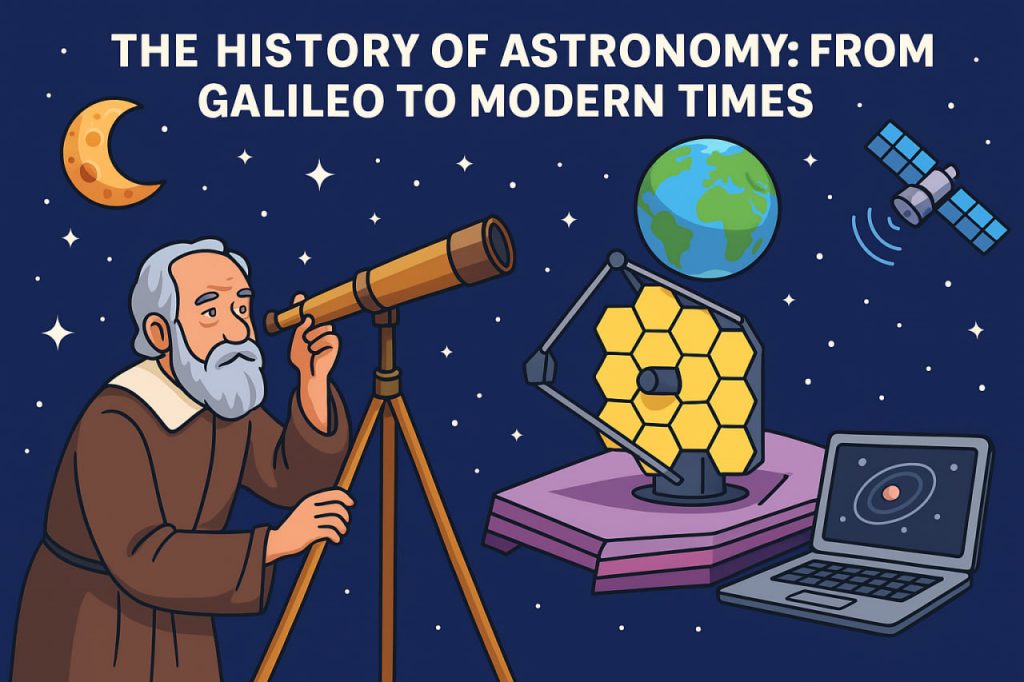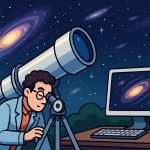Astronomy, one of the oldest sciences, has transformed dramatically over the centuries. From ancient stargazers to space telescopes, the journey of understanding the universe has passed through revolutions in observation, theory, and technology. While early civilizations tracked stars for agricultural and religious purposes, it was the Scientific Revolution of the 16th and 17th centuries that laid the foundation for modern astronomy.
This article traces the major milestones in astronomy—from Galileo Galilei and the invention of the telescope to today’s space-based observatories and exoplanet discoveries.
Galileo and the Birth of Modern Astronomy
In the early 1600s, Galileo Galilei used a telescope to observe celestial bodies, revolutionizing astronomy. He discovered the moons of Jupiter, the phases of Venus, and sunspots, providing strong evidence for the heliocentric model proposed by Copernicus. Galileo’s observations challenged the geocentric worldview endorsed by the Catholic Church and sparked debate across Europe.
This era also saw the work of Johannes Kepler, who formulated the three laws of planetary motion, and Isaac Newton, whose law of universal gravitation mathematically explained planetary orbits. These breakthroughs established a scientific framework that would define astronomy for centuries.
The 18th and 19th Centuries: Telescopes and Discovery
With larger and more powerful refracting and reflecting telescopes, astronomers in the 18th and 19th centuries expanded their knowledge of the Solar System. William Herschel discovered Uranus in 1781, the first planet found with a telescope. The discovery of Neptune, asteroids, and the identification of binary stars followed.
Astronomers began classifying stars by brightness and color, laying the groundwork for astrophysics. Photography and spectroscopy emerged in the 19th century, allowing scientists to analyze starlight and determine their composition and movement.
20th Century: The Rise of Astrophysics and Space Age
In the early 20th century, Edwin Hubble proved that the Milky Way was just one of many galaxies and that the universe is expanding. This discovery, along with Einstein’s general theory of relativity, changed our understanding of cosmology.
Radio astronomy was born with the detection of signals from space. The launch of satellites, especially the Hubble Space Telescope in 1990, allowed astronomers to observe the universe without atmospheric distortion. The field shifted from simple observation to astrophysics—the study of physical processes in space.
Modern Astronomy: Space Telescopes and Exoplanets
Today, astronomy is powered by space observatories like JWST (James Webb Space Telescope), ground-based mega-telescopes, and computer modeling. The discovery of exoplanets—planets orbiting stars outside our solar system—has become one of the most exciting fields, with thousands confirmed.
Gravitational waves, detected in 2015, opened a new window into cosmic events like black hole mergers. Missions like Gaia are mapping the galaxy in 3D, while others study the cosmic microwave background, providing insight into the origin of the universe.
Astronomy is now a global science, combining observations from many wavelengths—radio, infrared, X-ray, and gamma-ray—to build a complete picture of the cosmos.
Glossary
- Astronomy – the scientific study of celestial objects and the universe
- Heliocentric model – a theory where planets orbit the Sun
- Geocentric model – a belief that Earth is at the center of the universe
- Spectroscopy – the analysis of light to determine chemical composition
- Astrophysics – the study of the physical properties and behavior of celestial bodies
- Exoplanets – planets orbiting stars beyond the Solar System
- Gravitational waves – ripples in space-time caused by massive cosmic events


